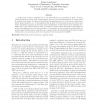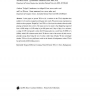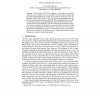56 search results - page 4 / 12 » The Anatomy of Chess Programs |
ICGA
2007
13 years 9 months ago
2007
In this paper it will be explained how to use bitboards for move generation in shogi. In chess, bitboards have been used in most strong programs because of the easy representation...
ML
2000
ACM
13 years 9 months ago
2000
ACM
In this paper we present TDLEAF( ), a variation on the TD( ) algorithm that enables it to be used in conjunction with game-tree search. We present some experiments in which our che...
CG
2000
Springer
14 years 2 months ago
2000
Springer
Abstract. Over the years, various research projects have attempted to develop a chess program that learns to play well given little prior knowledge beyond the rules of the game. Ea...
FPL
2004
Springer
14 years 3 months ago
2004
Springer
Abstract. With the help of the FPGA technology, the boarder between hardand software has vanished. It is now possible to develop complex designs and fine grained parallel applicat...
MICCAI
1998
Springer
14 years 2 months ago
1998
Springer
In this paper we present AnatomyBrowser, a framework for integration of images and textual information in medical applications. AnatomyBrowser allows the user to combine 3D surfac...



